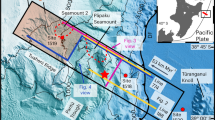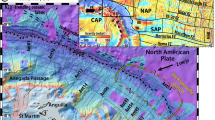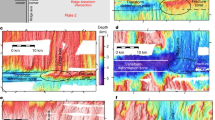Abstract
Subduction zones are often characterized by wedge-shaped sedimentary complexes—called accretionary prisms—that form when sediments are scraped off the subducting plate and added to the overriding plate. Large, landward-dipping thrust faults can cut through such a prism: these faults, known as ‘megasplay faults’1,2, originate near the top of the subducting plate and terminate at the shallow, landward edge of the prism1,3,4,5,6. Megasplay faults have been the subject of numerous geological and geophysical studies4,5,6,7,8,9,10,11,12,13,14,15, but their initiation and evolution through time remains poorly constrained. Here we combine seismic reflection data from the Nankai accretionary wedge with geological data collected by the Integrated Ocean Drilling Program (IODP) and find that the splay fault cutting this wedge initiated ∼1.95 Million years (Myr) ago in the lower part of the prism as an out-of-sequence thrust (OOST). After an initial phase of high activity, the movement along the fault slowed down, but uplift and reactivation of the fault resumed about 1.55 Myr ago. The alternating periods of high and low activity along the splay fault that we document hint at episodic changes in the mechanical stability of accretionary prisms.
This is a preview of subscription content, access via your institution
Access options
Subscribe to this journal
Receive 12 print issues and online access
$259.00 per year
only $21.58 per issue
Buy this article
- Purchase on Springer Link
- Instant access to full article PDF
Prices may be subject to local taxes which are calculated during checkout




Similar content being viewed by others
References
Fukao, Y. Tsunami earthquakes and subduction processes near deep-sea trenches. J. Geophys. Res. 84, 2303–2314 (1979).
Tobin, H. J. & Kinoshita, M. NanTroSEIZE: The IODP Nankai trough seismogenic zone experiment. Sci. Drill. 2, 23–27 (2006).
Plafker, G. Alaskan earthquake of 1964 and Chilean earthquake of 1960: Implications for arc tectonics. J. Geophys. Res. 77, 901–925 (1972).
Park, J.-O., Tsuru, T., Kodaira, S., Cummins, P. R. & Kaneda, Y. Splay fault branching along the Nankai subduction zone. Science 297, 1157–1160 (2002).
Moore, G. F. et al. Three-dimensional splay fault geometry and implications for tsunami generation. Science 318, 1128–1131 (2007).
Collot, J. Y., Agudelo, W., Ribodetti, A. & Marcailou, B. Origin of a crustal splay fault and its relation to the seismogenic zone and underplating at the erosional north Ecuador—south Colombia oceanic margin. J. Geophys. Res. 113, B12102 (2008).
Bangs, N. L. et al. Broad, weak regions of the Nankai Megathrust and implications for shallow coseismic slip. Earth Planet. Sci. Lett. 284, 44–49 (2009).
Kikuchi, M., Nakamura, M. & Yoshikawa, K. Source rupture processes of the 1944 Tonankai earthquake and the 1945 Mikawa earthquake derived from low-gain seismograms. Earth Planets Space 55, 159–172 (2003).
Baba, T., Cummins, P. R., Hori, T. & Kaneda, Y. High precision slip distribution of the 1944 Tonankai earthquake inferred from tsunami waveforms: Possible slip on a splay fault. Tectonophysics 426, 119–134 (2006).
Tanioka, Y. & Satake, K. Detailed coseismic slip distribution of the 1944 Tonankai earthquake estimated from tsunami waveforms. Geophys. Res. Lett. 28, 1075–1078 (2001).
Katsumi, K. Out-of-sequence thrust of an accretionary complex. Mem. Geol. Soc. Jpn 50, 131–146 (1998).
Kimura, G. et al. Transition of accretionary wedge structures around the up-dip limit of the seismogenic subduction zone. Earth Planet. Sci. Lett. 255, 471–484 (2007).
Morley, C. K. Out-of-sequence thrusts. Tectonics 7, 539–561 (1988).
Gutscher, M.-A., Kukowski, N., Malavieille, J. & Lallemand, S. Cyclical behavior of thrust wedges: Insights from high basal friction sandbox experiments. Geology 24, 135–138 (1996).
Wang, K. & Hu, Y. Accretionary prisms in subduction earthquake cycles: The theory of dynamic Coulomb wedge. J. Geophys. Res. 111, B06410 (2006).
Lay, T. et al. The great Sumatra–Andaman earthquake of 26 December 2004. Science 308, 1127–1133 (2005).
Ando, M. Source mechanisms and tectonic significance of historical earthquakes along the Nankai trough, Japan. Tectonophysics 27, 119–140 (1975).
Kame, N., Rice, J. R. & Dmowska, R. Effects of prestress state and rupture velocity on dynamic fault branching. J. Geophys. Res. 108, B5-2265 (2003).
Moore, G. F. et al. in Structural and Seismic Stratigraphic Framework of the NanTroSEIZE Stage 1 Transect: Proc. IODP 314/315/316 (eds Kinoshita, M. et al.) (Integrated Ocean Drilling Program Management International, 2009).
Kinoshita, M. et al. (eds) Expedition 316 Scientists. Expedition 316 Site C0004: Proc. IODP 314/315/316 (Integrated Ocean Drilling Program Management International, 2009).
Kinoshita, M. et al. (eds) Expedition 316 Scientists. Expedition 316 Site C0008: Proc. IODP 314/315/316 (Integrated Ocean Drilling Program Management International, 2009).
Van Andel, T. H. Mesozoic/Cenozoic calcite compensation depth and the global distribution of calcareous sediments. Earth Planet. Sci. Lett. 26, 187–194 (1975).
Seno, T., Stein, S. & Gripp, A. E. A model for the motion of the Philippine sea plate consistent with Nuvel-1 and geological data. J. Geophys. Res. 98, 17941–17948 (1993).
Miyazaki, S. I. & Heki, K. Crustal velocity field of southwest Japan: Subduction and arc–arc collision. J. Geophys. Res. 106, 4305–4326 (2001).
Kinoshita, M. et al. (eds) Expedition 315 Scientists. Expedition 315 Site C0002: Proc. IODP 314/315/316 (Integrated Ocean Drilling Program Management International, 2009).
Kodaira, S. et al. Cyclic ridge subduction at an inter-plate locked zone off central Japan. Geophys. Res. Lett. 30, 1339 (2003).
Park, J.-O., Moore, G. F., Tsuru, T., Kodaira, S. & Kaneda, Y. A subducted oceanic ridge influencing the Nankai megathrust earthquake rupture. Earth Planet. Sci. Lett. 217, 77–84 (2003).
Bangs, N. L. B., Gulick, S. P. S. & Shipley, T. H. Seamount subduction erosion in the Nankai Trough and its potential impact on the seismogenic zone. Geology 34, 701–704 (2006).
Screaton, E. J., Saffer, D., Henry, P. & Kunze, S. Porosity loss within the underthrust sediment of the Nankai accretionary complex: Implications for overpressures. Geology 30, 19–22 (2002).
Saffer, D. & Bekins, B. A. Hydrologic controls on the morphology and mechanics of accretionary wedges. Geology 30, 271–274 (2002).
Acknowledgements
This research used samples and data provided by the Integrated Ocean Drilling Program (IODP). This work was supported by fellowship grants from the Swiss National Science Foundation (Grant No PBEZ2-118865) and the DFG-Research Centre/Cluster of Excellence ‘The Ocean in the Earth System’ (to M.S.), the US National Science Foundation to the University of Hawaii (G.M.) and the Japanese Ministry of Education, Culture, Science, Sports, and Technology to JAMSTEC.
Author information
Authors and Affiliations
Contributions
M.S., paper writing, lithostratigraphy, data integration, conceptual model; G.M., paper writing, seismic stratigraphy, conceptual model, project planning; G.K., E.J.S., project planning, data integration, J.-O.P., seismic data processing, conceptual model; A.J.K., S.L., conceptual model; Y.K., X.Z., magnetostratigraphy, X.S., biostratigraphy, M.B.U., lithostratigraphy, mineralogy, data integration.
Corresponding author
Supplementary information
Supplementary Information
Supplementary Information (PDF 416 kb)
Rights and permissions
About this article
Cite this article
Strasser, M., Moore, G., Kimura, G. et al. Origin and evolution of a splay fault in the Nankai accretionary wedge. Nature Geosci 2, 648–652 (2009). https://doi.org/10.1038/ngeo609
Received:
Accepted:
Published:
Issue Date:
DOI: https://doi.org/10.1038/ngeo609
This article is cited by
-
Three-dimensional topographic relief of the oceanic crust may control the occurrence of shallow very-low-frequency earthquakes in the Nankai Trough off Kumano
Earth, Planets and Space (2020)
-
Simultaneous estimation of in situ porosity and thermal structure from core sample measurements and resistivity log data at Nankai accretionary prism
Earth, Planets and Space (2019)
-
Morphometric signature of sediment particles reveals the source and emplacement mechanisms of submarine landslides
Landslides (2019)
-
Mantle-derived fluids in the Nankai Trough Kumano forearc basin
Progress in Earth and Planetary Science (2018)
-
Punctuated growth of an accretionary prism and the onset of a seismogenic megathrust in the Nankai Trough
Progress in Earth and Planetary Science (2018)



